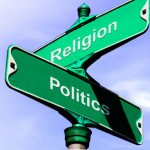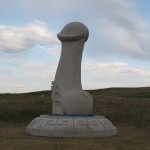Over at Patheos, two weeks after Star Foster lauded the praises of traditional initiatory Wicca, which included such points as “Hierarchy is good” and “Wicca-focused Wicca”, she now has raised the issue of Christian elements, like the Watchtowers, in traditional Wicca. This was followed by a second post asking whether Wicca is a Christian heresy, which has really drawn some attention, mine at least.
In her latest post, Star writes:
“It makes me reconsider my ideas regarding the rise of popular Wicca and the Reconstructionist religions. There seems to be a general feeling that traditional Wicca is rejected because it’s either hard to find, too hard or in some cases, abusive. I’m not saying that those aren’t still reasons traditional Wicca is rejected, but with the rise of Reconstructionism, I have to wonder if traditional Wicca is rejected in favor of popular Wicca or Reconstructionism because it’s not Pagan enough?”
To this last question, I have to answer for myself “yes”. But I’m not alone. In Wicca and the Christian Heritage (2007), Jo Pearson writes that, while Wicca has been instrumental in the development of a variety of forms of Neopaganism, “the relationship between Wicca and Paganism has changed over the years, and indeed, the notion of Wicca as a form of Paganism now needs to be challenged.” She observes that it can no longer be said that all Wiccans are Pagans: “In many ways initiatory Wicca can be regarded as existing on the margins of Paganism.”
A decade earlier, in New Age Religion and Western Culture (1996), Wouter Hanegraaff stated that he might not have even included Wicca in his survey of Neopganism if it had remained a “relatively self-contained England-based occultist religion”. He explains that this is because “traditional Wicca, in particular, is rooted in traditional occultist ritual magic, and still retains much of that legacy. […] The complicating factor with regard to our concerns is that Wicca is a neopagan development of traditional occultist ritual magic, but that the latter movement is not itself pagan.” (emphasis added).
And a decade before that, in Religious and Spiritual Groups in Modern America (1987), Robert Ellwood and Harry Partin were already drawing the same conclusion:
“The Neo-Pagan movement breaks down into two broad categories: the magical groups, deeply influenced by the model of the Order of the Golden Dawn, the O.T.O., and Crowley; and the nature oriented groups. The former are the more antiquarian; they love to discuss editions of old grimoires, and the complicated histories of groups an lineages. They delight in precise and fussy ritualism, though the object is the evocation of intense emotional power […]
“The pagan nature-oriented groups are more more purely romantic; the prefer woodsy setting to incense and they dance and plant trees. They are deeply influenced by Robert Graves, especially his White Goddess. They are less concerned with evocation than celebration of the goddesses they know are already there. The mood is spontaneous rather than precise, though the rite may be as beautiful and complex as a country dance. […]
“Wicca itself is in the middle between magic and nature-oriented groups.”
I find it helpful to think of Neo paganismand occultism as two circles circumscribing different cultural phenomena with overlapping circumferences. Traditional Wicca would fall within the overlapping area, whereas many other forms of Neopaganism would fall largely outside of the circle of occultism. This challenges the notion that Wicca is the esoteric center of which Paganism constitutes an exoteric manifestation.
There are good reasons for distinguishing Wicca from Neopaganism on the basis of the influence of occultism. Take for example Star’s description of one influence of ceremonial magic on traditional Wicca:
“In the Kabbalistic Cross humanity is placed at the center of the Universe, in the Lesser Banishing Ritual of the Pentagram humanity exerts it’s will over the elements of the universe, and in the ultimate act of Dominionism the Gods themselves are summoned by the Wiccan into an energetic circle in which they are confined until being released.”
Now contrast that with the attitude of Neopaganism. As Robert Ellwood and Harry Partin explain:
“The unifying theme among the diverse Neo-Pagan traditions is the ecology of one’s relation to nature and to the various parts of one’s self. As Neo-Pagans understand it, the Judaeo-Christian tradition teaches that the human intellectual will is to have dominion over the world, and over the unruly lesser parts of the human psyche, as it, in turn, is to be subordinate to the One God and his will. The Neo-Pagans hold that, on the contrary, we must cooperate with nature and its deep forces on a basis of reverence and exchange. Of the parts of man, the imagination should be first among equals, for man’s true glory is not in what he commands, but in what he sees. What wonders he sees of nature and of himself he leaves untouched, save to glorify and celebrate them.”
These seem to be two different paradigms: the first, occultist, resembling Starhawk’s concept of “power with” and the latter, Neopagan, resembling her concept of “power over”.
Star writes:
“I was disturbed by my first encounter with trad Craft finding I was expected to learn and practice exercises full of Judeo-Christian concepts and language. I wasn’t disturbed because ‘I hatez the Xtians’ but because if I wanted Jewish or Christian mysticism there are better resources out there than Wicca. I wanted Pagan Witchcraft: deep, thoughtful, potent practice to align myself with nature and the Old Gods.”
My response to Star would be: If you want a deep, thoughtful, and potent practice to align yourself with nature and the Old Gods, then go outside, take off your shoes, stick your fingers in the dirt, and listen … listen to the world around you and listen to the deep world within you.
In her book, Rebirth of the Goddess, Carol Christ describes a transformation in her spirituality which she experienced when she moved to Greece from Wicca to a more Pagan practice. Her experience illustrates the difference between occultist magic and Neopagan spirituality. She writes that, in her early magical practice, she “often felt that we were ‘creating’ the Goddess as we called her into our lives.” She states that the forms of ceremonial magic employed by Neopagan witches (opening and closing the circle, calling the directions, raising the cone of power, casting spells) ironically often left her feeling “ungrounded”.
When she moved to Greece, Christ initially saw the forms of Greek Christian devotion, like lighting candles and bringing votive offerings to icons, to be expressions of the patriarchal Christianity which she had rejected. However, she came to see that these practices were “ rooted in simple and meaningful gestures that are far more ancient than Christianity.” And she began to embrace these practices and incorporate them into her Neopagan feminist spirituality. She writes:
“I realized that the Goddess had never died! She could not die because she was in the land, she was the land. Now instead of coming into my head, the Goddess rises through my feet. She surrounds me in the air I breathe. I don’t have to create her. She is. My ritual practice has become simplified. Like the Greeks, I light candles, kiss the icon of the Mother, and tell her what is in my heart. Or I pour a libation of milk or honey, water or wine, on a stone I have set beneath a myrtle tree growing in a pot on my balcony, sing to the image of the Goddess that nestles beneath the tree, and tell her what I need. Because the Goddess has entered into my bones and because I see her in my home and in nature, I no longer feel the need to follow elaborate ritual procedures to call her into my life.”
She concludes that, although she was introduced to Goddess worship through witchcraft, she no longer resonates with the practice of magic as defined by Neopagan witches:
“I still find meaning in attuning myself to the rhythms of the moon and celebrating the seasons of the year. But as my experience of the Goddess becomes rooted in the Greek land, I find my practice more and more inspired by nature itself […] Spell casting was for me, yet another head-trip, a very American way of trying to control reality and achieve individual desire. I now find that my needs are better met by my remaining open to what life has to offer than by trying to mold reality to my will.”
The influence of occultism on Wicca I think is another good reason for adopting Isaac Bonewits’ 3-part classification of Paganism:
1. “Paleo-Paganism” referring to the original polytheistic, nature-centered faiths of the world. Surviving examples include Hinduism, Taoism, and Shinto.
2. “Meso-Paganism” referring to attempts to recreate Paleo-Paganism, but heavily influenced by the monotheistic, dualistic, or nontheistic worldviews of Judaism, Christianity, Islam, etc. Examples include Freemasonry, Rosicrucianism, Theosophy, Spiritualism, those forms of Druidism influenced by those movements, the many Afro-Diasporatic faiths (Voudoun, Santeria, Candomble, etc.), Aleister Crowley’s Thelema, some Norse Paganism, most “Family Traditions” of Witchcraft, and most orthodox (aka “British Traditionalist”) denominations of Wicca.
3. “Neo-Paganism” referring to movements started since in the 1960s but having literary roots going back to the mid-19th century, as attempts to recreate Paleopaganism, but blended with modern humanistic, pluralist and inclusionary ideals, while consciously striving to eliminate as much as possible of the traditional Western monotheism, dualism, and puritanism. Examples of Neopaganism would include the Church of All Worlds, most heterodox [what Star calls “popular”] Wiccan traditions, Druidism as practiced by Ár nDraíocht Féin and the Henge of Keltria, some Norse Paganism, etc.
If we can draw this distinction between Meso-Pagan traditional Wicca and Neo-Pagan “popular” or “heterodox” Wicca, then some of the discord between BTW and Neo-Wicca might be ameliorated. I think some of the conflict arises because these two groups use the same name, and therefore there is an expectation they will be doing the same thing, which creates dissonance when they turn out to be a very different beasts.
The challenge this presents is that Meso-Wiccans would need to acknowledge that what distinguishes them from Neo-Wiccans and Neo-Pagans is (1) the influence of occultism and (2) the influence of Christianity. I’ve written about the influence of occultism above. The influence of Christianity on Wicca and Neopaganism will be the subject of a future post.















